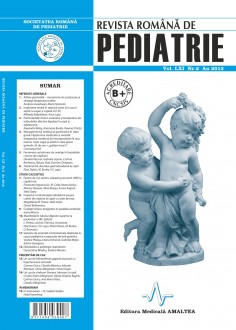SELECT ISSUE

Indexed

| |

|
|
|
| |
|
|
|

|
|
|
|
|
|
|
HIGHLIGHTS
National Awards “Science and Research”
NEW! RJP has announced the annually National Award for "Science and Research" for the best scientific articles published throughout the year in the official journal.
Read the Recommendations for the Conduct, Reporting, Editing, and Publication of Scholarly work in Medical Journals.
The published medical research literature is a global public good. Medical journal editors have a social responsibility to promote global health by publishing, whenever possible, research that furthers health worldwide.
Clinical imaging correlations in cerebral palsy
ABSTRACT
Cerebral palsy is a group of persistent (but not necessarily unchanged), movement, posture, muscle tone, and motor skills disorders, non-progressive, with early onset, due to non-progressive impairments, occurring on an immature brain or a brain under development (prenatal, perinatal, postnatal during the fi rst 3-4 years of life). [1] It is associated to a variable extent with: cognitive disorders, epilepsy, sensory deficits, behaviour disorders. The aetiology of cerebral palsy is sometimes difficult to identify, and neuroimaging plays an important role in this respect. The aim of this study is to review the results of the imaging investigations in relation to the clinic.
Material and method: it is a retrospective trial of the patients hospitalized in the Paediatric Neurology Clinic of the Al Obregia Hospital in 2010 with the diagnosis of cerebral palsy, who underwent imaging investigations.
Results and conclusions: 379 children were analysed. Most children (>87%) with cerebral palsy had neuroradiological abnormalities. In terms of frequency, white matter lesions were the most frequent, followed by white and grey matter lesions. Periventricular white matter lesions were correlated with spastic diparesis. White and grey matter lesions were coupled with spastic hemiparesis, and grey matter lesions with dyskinetic forms. Malformations were significantly associated with ataxic forms and spastic hemiparesis. The imaging was more frequently normal in spastic diparesis. The data are consistent with those in literature. Imaging investigations are intended to contribute to the understanding of aetiology and pathogenesis, the setting of a prognosis, and in the future in finding a prophylaxis.
Key words: cerebral palsy, magnetic resonance imaging, computed tomography
